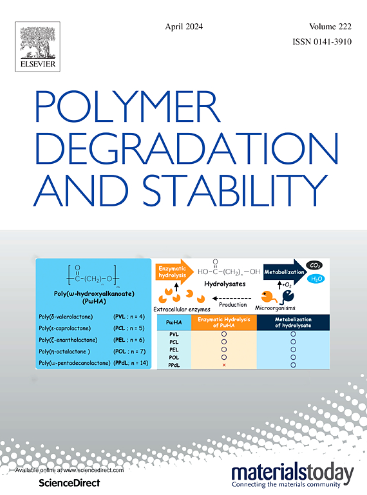尿素键低聚物制备多功能聚乙烯醇/聚脲杂化水凝胶的热行为
IF 6.3
2区 化学
Q1 POLYMER SCIENCE
引用次数: 0
摘要
一种具有抗菌性能和高耐热性的创新型混合水凝胶已经研制成功。这种新型水凝胶是通过将尿素连接低聚物(ULO)与 PVA 聚合物交联而成。ULO 是在熔融状态下利用氨基磺酸、磷酸和尿素通过缩合反应生成的。水凝胶的表征采用了 SEM 显微镜、离子色谱技术、FT-IR、DSC、TGA 和 LOI 分析。热压交联后,聚脲网络、矿物盐颗粒(硫酸铵、磷酸盐、硝酸盐和三聚氰胺)透过聚合物层被识别出来,聚合物薄膜的耐热性得到增强。研究的重点是热解过程中产生的产物。样品释放出的易燃挥发性气体受到所用原材料数量和生产条件的影响。PVA 分解产生的最易燃气体包括乙醛、2-丁烯醛和 2,4-己二烯醛。尿素及其低聚物产生的活性可燃气体是氰酸和氰酰胺。根据 DSC 曲线计算出了这些样品的热裂解焓,并对其进行了讨论。改性聚合物具有优异的阻燃性能,500 °C 时的 LOI 为 48%,炭含量为 37.28%。这种尿素低聚物通过稀释挥发性气体、产生抗性泡沫涂层和形成碳炭来控制燃烧的机制仍有待商榷。本文章由计算机程序翻译,如有差异,请以英文原文为准。
The thermal behavior of multifunctional polyvinyl alcohol/polyurea hybrid hydrogel prepared from oligomers with urea linkage
An innovative hybrid hydrogel with antibacterial properties and high heat resistance has been developed. This new hydrogel is created by crosslinking urea linkage oligomer (ULO) with PVA polymer.
The ULO is produced through a condensation reaction in a molten state, using sulfamic acid, phosphorous acid, and urea. The polymer film is prepared in an aqueous environment by mixing the materials, molding, and applying heat pressing.
The characterization of hydrogel was reported using an SEM microscope, ion chromatography technique, FT-IR, DSC, TGA, and LOI analysis. After heat pressing and crosslinking, polyurea networks, mineral salt particles; ammonium sulfate, phosphates, nitrates, and melamine are identified through the polymer layer, and the heat resistance of polymer films is enhanced. The study focused on the products generated during the pyrolysis process. Flammable volatile gases released from the samples were affected by the amounts of raw materials used and the production conditions. The most flammable gases from PVA decomposition include acetaldehyde, 2-butenal, and 2,4-hexadienal. The active and combustible gases from urea and its oligomers are cyanic acid and cyanamide. These samples' thermal pyrolysis enthalpy was calculated from the DSC curve and discussed. The modified polymer demonstrates excellent flame-retardant properties, with an LOI of 48 % and a char content of 37.28 % at 500 °C. The mechanism by which this urea oligomer controls ignition through the dilution of volatile gases, the production of a resistant foam coating, and the formation of carbon char remains debatable.
求助全文
通过发布文献求助,成功后即可免费获取论文全文。
去求助
来源期刊

Polymer Degradation and Stability
化学-高分子科学
CiteScore
10.10
自引率
10.20%
发文量
325
审稿时长
23 days
期刊介绍:
Polymer Degradation and Stability deals with the degradation reactions and their control which are a major preoccupation of practitioners of the many and diverse aspects of modern polymer technology.
Deteriorative reactions occur during processing, when polymers are subjected to heat, oxygen and mechanical stress, and during the useful life of the materials when oxygen and sunlight are the most important degradative agencies. In more specialised applications, degradation may be induced by high energy radiation, ozone, atmospheric pollutants, mechanical stress, biological action, hydrolysis and many other influences. The mechanisms of these reactions and stabilisation processes must be understood if the technology and application of polymers are to continue to advance. The reporting of investigations of this kind is therefore a major function of this journal.
However there are also new developments in polymer technology in which degradation processes find positive applications. For example, photodegradable plastics are now available, the recycling of polymeric products will become increasingly important, degradation and combustion studies are involved in the definition of the fire hazards which are associated with polymeric materials and the microelectronics industry is vitally dependent upon polymer degradation in the manufacture of its circuitry. Polymer properties may also be improved by processes like curing and grafting, the chemistry of which can be closely related to that which causes physical deterioration in other circumstances.
 求助内容:
求助内容: 应助结果提醒方式:
应助结果提醒方式:


